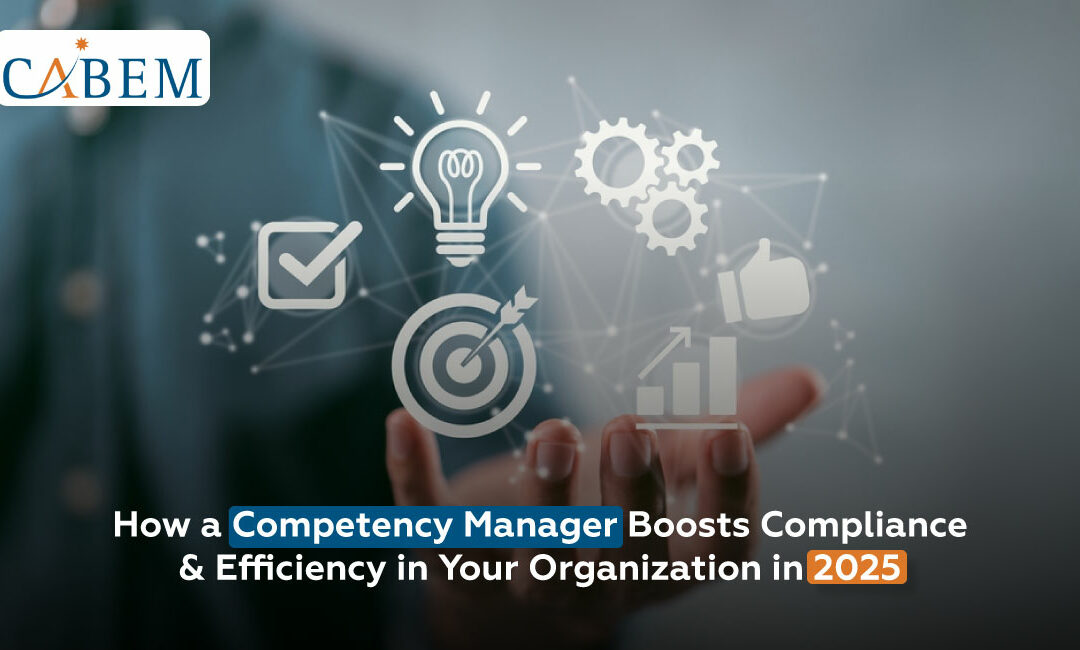Did you know that 83% of organizations report that developing skills in their talent pool is their number one priority for remaining competitive in today’s rapidly changing business environment? However, despite these initiatives, companies continue to experience widespread challenges in compliance, upskilling, and productivity.
The demands to meet regulatory standards while ensuring a high-performing workforce are intensifying. By 2025, organizations must be more agile, efficient, and compliance-conscious than ever. As automation and digital tools transform industries, traditional manual processes will no longer be enough.
This blog post will discuss how adopting a competency manager ensures compliance and drives organizational efficiency. We’ll explain why organizations struggle with workforce compliance, what a competency manager is, and how it can automate compliance tracking, streamline training, and save your organization time and money. Stay tuned to learn how this simple yet powerful tool can help keep your workforce future-ready.
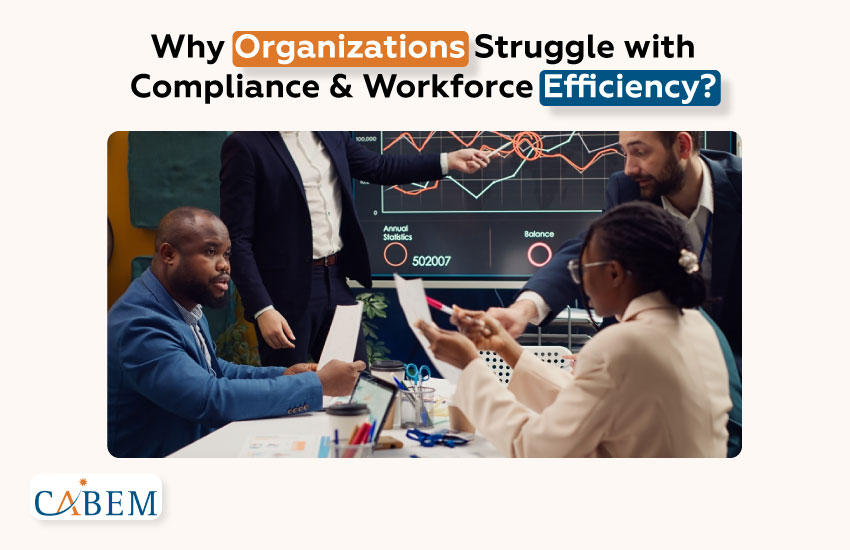
Why Organizations Struggle with Compliance & Workforce Efficiency?
For many organizations, staying compliant while maximizing workforce productivity is often a formidable challenge in today’s advanced technological business landscape. Regulatory risks aside, these challenges also hamper operational productivity. Now, let’s explore some of the reasons for the difficulties.
Inconsistent Training & Certification Tracking
Accurately tracking employee training and certifications is critical, especially in industries subject to strict regulatory requirements. Yet, many organizations fail to track these activities regularly, creating exposure gaps in compliance. For instance:
- According to a survey by Secureframe, 70% of corporate risk and compliance professionals have noticed a shift away from essential compliance and toward a more strategic mindset over the past several years — evidence that better training and certification tracking are needed. (Secureframe)
- Businesses in South Australia have reported frustrations on increased regulatory demands, stating that around 57% of companies feel that regulatory requirements have increased and that there is a desire for improved tracking systems. (Adelaide Now)
High Cost of Non-Compliance
The cost of non-compliance is not limited to the impact of fines only; lost productivity, legal fees, and reputational damage occasionally cost more than the initial fine incurred. Here are a few statistics to consider:
- Companies investing in robust safety compliance programs have experienced 40% or more cost reductions when it comes to accident-related expenses, highlighting the financial gains associated with compliance. (HVI)
- In fact, the financial sector has paid more than $321 billion in fines and settlements since 2008 for non-compliance so you can imagine the dire financial risk involved. (Wikipedia)
Lack of Real-Time Visibility
Organizations without real-time visibility into employee proficiencies and compliance statuses face a greater risk of being left behind. It can also lead to a lack of visibility:
- Increased difficulty adapting to new regulations, as businesses may not promptly identify areas needing adjustment.
- Managing a global workforce can be challenging, mainly due to different compliance requirements in various parts of the world. (Remire)
Manual Processes & Human Errors
Manual tracking of competencies and certifications is not only time-consuming but also comes with a risk of errors and inconsistencies. This approach can result in:
- Added administrative workload, with employees investing substantial time in compliance-related tasks.
- Errors may happen in payroll and compliance reporting, leading to legal and financial repercussions. (The Australian)
To tackle these challenges, organizations should focus on comprehensive competency management solutions. These systems provide automated tracking, real-time analytics, and streamlined processes, helping organizations stay compliant and work efficiently.
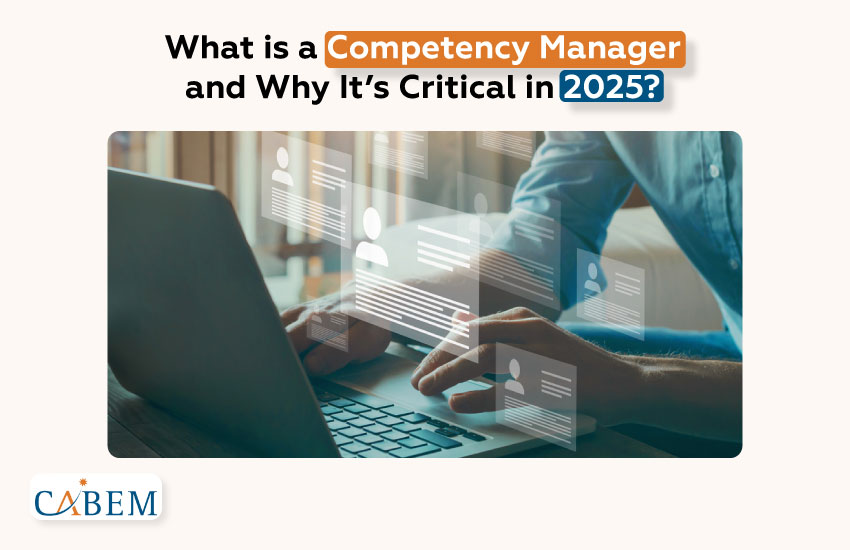
What is a Competency Manager and Why Is It Critical in 2025?
With their rapidly evolving business environment, organizations today struggle to identify skills and competencies in their workforce that can meet changing demands.
Competency Manager software allows you to identify, develop, and track the skills, knowledge, and behaviors necessary for your employees to succeed in their roles. This tool enables companies to define specific competencies, align them with strategic business objectives, and comply with industry standards and regulations.
The Imperative for Competency Management in 2025
Why is competency management indispensable in 2025? As technological advancements rapidly transform industries, regulatory landscapes evolve, and organizations strive for more agility, robust competency management becomes increasingly critical.
- AI and Automation Impact: Up to 300 million global jobs have been replaced by AI, demanding sustained workforce reskilling and upskilling efforts. (AIHR)
- Skill Evolution: Due to technological advancements, nearly 50% of the workers are expected to get changes made to their core skills. (AIHR)
- Market Growth: The market for competency management software is expected to grow at a high CAGR between 2023 and 2033. The demand for keeping employees productive and competent will increase even further during this period. (Archive Market Research)
These trends indicate the pressing need for organizations to embrace competency management systems to stay competitive and compliant on a broader level.
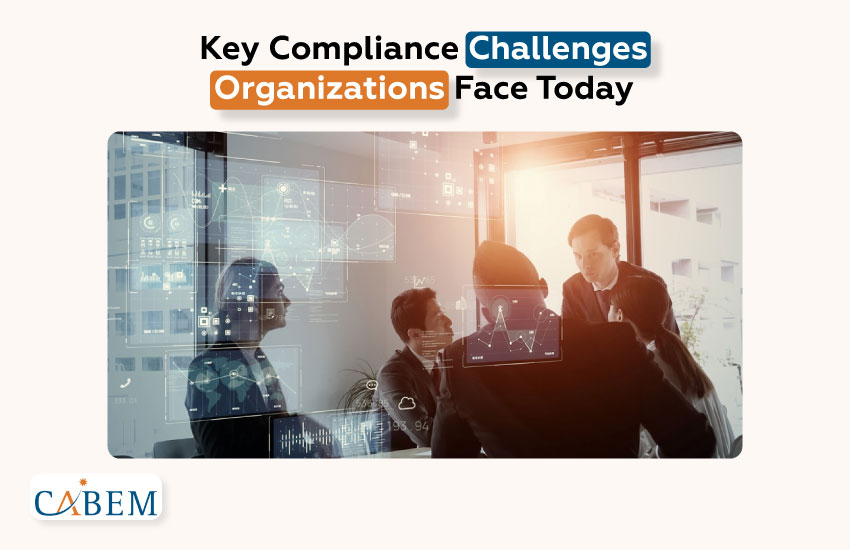
Key Compliance Challenges Organizations Face Today
As regulations continue to shift in the current regulatory environment, organizations face a wide range of compliance obstacles that can significantly affect their operations. Understanding these challenges is essential for developing effective compliance strategies.
Let’s dive into the main challenges organizations face:
Inconsistent Training & Certification Tracking
- Problem: If businesses do not have a centralized system for monitoring employee training and certifications, they can risk missing key compliance requirements.
- Impact: Failing to meet training deadlines or renewing certifications can result in fines and legal penalties.
Real-World Example: A survey conducted in Australia by payroll software company Yellow Canary found that, throughout the finance, telecommunications, and construction industries, 20% of the employers suspect they are incorrectly paying their staff in light of new wage theft laws in Australia. (The Australian)
Solution: A Competency Manager provides an overview of certifications in one centralized platform so you can ensure that all employees have the latest certifications.
High Cost of Non-Compliance
- Problem: Compliance violations can be costly, not only in terms of fines but also in terms of reputation and lost business.
- Impact: If a company does not comply, regulators can crack down and fine them millions. Moreover, clients can terminate contracts with non-compliant businesses.
Real-World Example: TD Bank, one of Canada’s biggest banks, was fined more than $3 billion for negligence and failure to protect against money laundering, drug trafficking, and terror financing from 2014 to 2023. (Financial Times)
Solution: A Competency Manager automates compliance tracking and provides an up-to-date overview of needed certifications, minimizing the risk of costly violations.
Lack of Real-Time Visibility
- Problem: Organizations cannot identify potential risks and inefficiencies in their workforce without up-to-date information about employee skills.
- Impact: This lack of visibility can result in missed compliance deadlines or discovering skills gaps too late.
Real-World Example: A United States military watchdog agency found that Navy officials were not fully aware of the risks of having massive fuel tanks overhead of a drinking water well at Pearl Harbor, which had caused a leak of jet fuel in 2021 that contaminated water and put more than 6,000 people at risk. (AP News)
Solution: A Competency Manager gives managers instant access to employee competency data, helping them make better-informed decisions about training and compliance.
Manual Processes & Human Errors
- Problem: Human error is quite probable when manually tracking competencies and certifications.
- Impact: Basic errors like data entry mistakes and missed deadlines lead to compliance concerns and inefficiencies.
Real-World Example: The British Post Office scandal occurred due to the wrongful prosecution of sub-postmasters based on errors in the Horizon IT system, resulting in significant financial loss and reputational damage. (Wikipedia)
Solution: Implementing a Competency Manager can automate these tedious processes, provide accurate, up-to-date data, reduce the risk of process errors, and improve overall productivity.
Moreover, a competent Competency Manager can address these compliance challenges to improve efficiency, minimize risks, and uphold a good reputation in their industry.
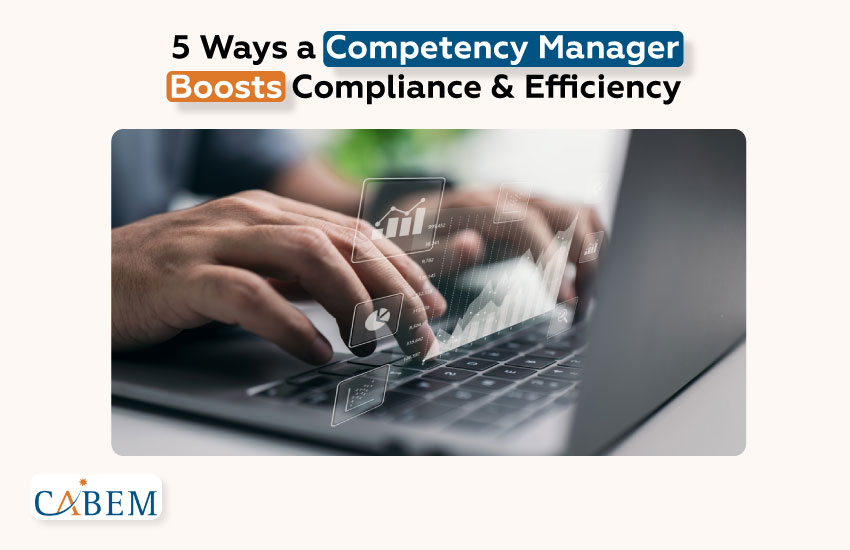
5 Ways a Competency Manager Boosts Compliance & Efficiency
Organizations are under increasing pressure to comply with these evolving regulations while simultaneously maintaining operational efficiency. A competency manager acts as a pivotal tool in achieving these goals. It improves compliance and efficiency across multiple lines of a business by automating processes and providing real-time insights.
- Automates Compliance Tracking
- Streamlined Training & Certification
- Reduces Operational Risks & Penalties
- Improves Workforce Productivity
- Saves Time & Costs
1. Automates Compliance Tracking
Problem: Monitoring compliance manually for every employee is tedious and error-prone.
Impact: Without automated tracking and compliance monitoring, organizations are prone to missing major compliance deadlines, which can result in fines and legal consequences.
Solution: Competency Manager automates tracking for required certifications, qualifications, and training for roles and competencies without manual intervention
Real-World Example: CABEM’s Competency Manager was implemented by Mill Steel, a steel manufacturing company, enabling them to double their facilities and train all new employees virtually. By automatically validating transactions against specific criteria, they could immediately respond to compliance triggers, leading to more efficient compliance processes, minimizing the risk of human error, and enabling alignment with industry standards. (CABEM Technologies)
2. Streamlined Training & Certification
Problem: The disjointed systems that track their training progress can lead to missed development opportunities and compliance issues.
Impact: Without proper training tracking, employees could remain unskilled, which may affect overall performance and increase the risk of non-compliance.
Solution: A Competency Manager provides a centralized place to access the training resources needed and keeps track of employee progress, ensuring training is completed on time and certifications are up to date.
Supporting Data: According to the Society for Human Resource Management (SHRM), an alarming 93% of 500 senior managers surveyed say competence models are both highly effective and essential for the success of any organization. (Twiser)
3. Reduces Operational Risks & Penalties
Problem: Failure to comply with regulations can result in heavy fines, penalties, and reputational harm.
Impact: Regulators can impose hefty fines for non-compliance, while clients can end contracts with businesses that fail to comply, causing a decrease in revenue and damaging reputation.
Solution: The Competency Manager keeps the records of competencies up to date and helps to ensure that employees are qualified and adequately trained, thereby reducing the risk of non-compliance.
Case Study: The Lee Company manufactures precision fluid control solutions that use CABEM’s Competency Manager to manage employee skills that are key to their industrial success. This system guarantees quality assurance in mission-critical applications, minimizes operational risks, and improves compliance. (CABEM Technologies)
4. Improves Workforce Productivity
Problem: Inconsistent tracking of competencies or skill sets delays, creates mistakes, and reduces efficiency. (CABEM Technologies)
Impact: Employees can duplicate efforts or lack clarity on responsibilities when a unified system is not in place, leading to inefficiencies.
Solution: A Competency Manager centralizes competency data, minimizing manual tracking and coordination time, enabling employees and managers to engage in more productive tasks.
Empirical Evidence: Research has first-hand pointed to how the use of competency management systems can lift the productivity of a workforce by ensuring the appropriate skills needed are aligned to the organization, creating smooth operations.
5. Saves Time & Costs
Problem: Manual competency management processes require a lot of time and resources.
Impact: The dependence on manual methods takes up resources from strategic initiatives, increases operational costs, and makes your organization less competitive.
Solution: Automating competency management through Competency Manager saves significant time and money, allowing teams to focus on mission-critical activities without compromising productivity and compliance.
Statistical Insight: According to a report, 83% of organizations consider skill development and lifelong learning to keep their workforce up to date with technological changes.
Implementing a Competency Manager in your organization optimizes compliance and training processes and improves efficiency, risk management, and productivity. For organizations seeking to stay ahead in today’s complex regulatory landscape, adopting such systems is a must.
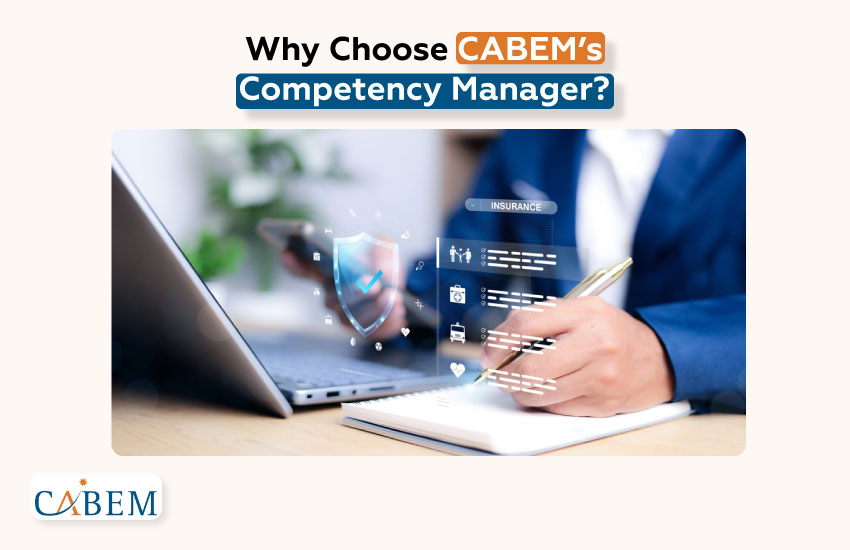
Why Choose CABEM’s Competency Manager?
CABEM provides customized competency management solutions to enhance workforce development within our organizations. Our platform will work to fit your organization’s unique requirements, allowing you to automate compliance tracking, streamline training, and ensure workforce productivity. Here’s what sets CABEM’s Competency Manager apart:
- Customization: Adjust the framework to suit your specific business requirements.
- Real-Time Reporting: All time ready for audits compliance with a full grasp of data.
- Seamless Integration: It integrates perfectly with your software and data.
- Global Accessibility: Centralized content is accessible to international teams, aligning your workforce and keeping everyone working off the same playbook.
- Proven Success: Over 925 active users, proven solutions to workforce development for Mill Steel, Broward County Sheriff’s Office, and Harvard Medical.

Ready to Simplify Compliance & Workforce Efficiency? Book a Demo Today!
As companies face growing regulatory pressures and a rapidly changing workforce, using a competency manager is becoming a must. It simplifies compliance tracking, improves training processes, and helps reduce risks, all while saving time and cutting costs.
By implementing this kind of system in your organization, you’ll not only stay compliant but also build a more capable, adaptable team ready for whatever comes next. Embracing a Competency Manager is the smart way to keep your business competitive and future-proof.
The future of workforce management is here. Are you ready to get your organization on track with compliance and workforce optimization? Book a demo with CABEM and see how Competency Manager can help you achieve your goals.
FAQs
What does a competency manager do?
A competency manager automates the tracking and management of employee competencies, certifications, and training. By providing clear visibility into skills, certifications, and training progress, a competency manager helps ensure compliance with industry standards while optimizing workforce performance.
How is competency management helpful at all levels of an organization?
The competency manager automates the tracking and managing of employee competencies, certifications, and training. This allows for greater visibility of skills, certifications, and training progress, which in turn helps ensure compliance with industry standards and optimizes workforce performance.
What challenges do you face in applying your competencies effectively?
Competency management faces challenges like inconsistent tracking, lack of real-time visibility, manual processes, and high cost of non-compliance. Such challenges can be addressed with a complete Competency Manager that automates tracking, offers real-time data, and minimizes human error.
Why do compliance programs fail?
Many compliance programs fail because they do not keep track of everything consistently, have little visibility into whether employees are progressing, and often operate through manual processes that leave room for human error. A Competency Manager addresses these challenges by automating compliance management, centralizing qualification training, and providing real-time insights into employee competencies.

